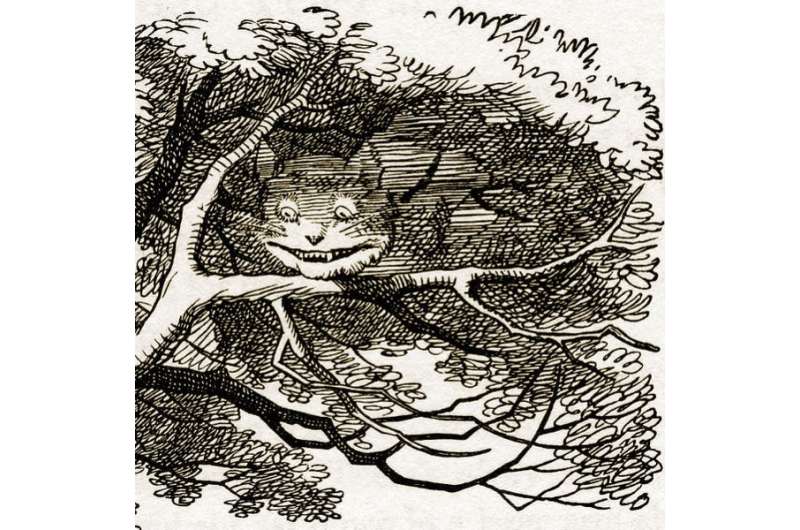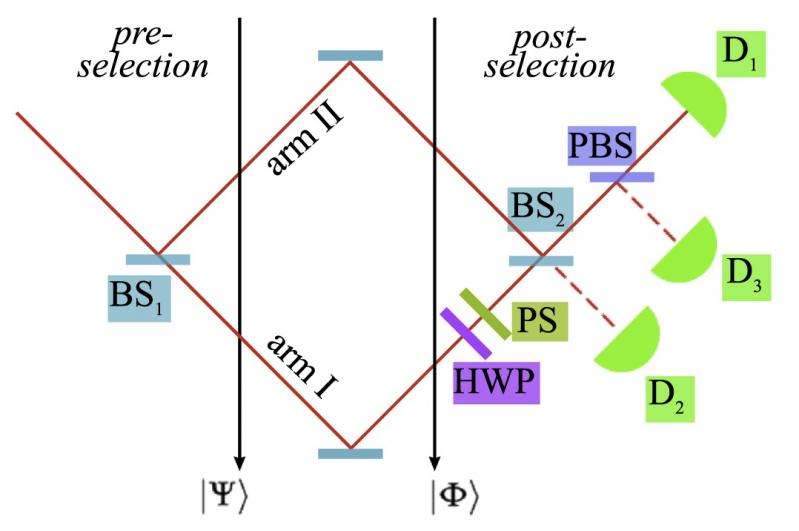June 8, 2015 feature
Quantum Cheshire Cat effect may be explained by standard quantum mechanics

(Phys.org)—"A grin without a cat" is how Lewis Carroll describes the Cheshire Cat's mysterious way of disappearing while leaving its grin behind in his 1865 classic, Alice in Wonderland. The fanciful character raises a question that has captured physicists' attention over the past few years: can an object be separated from its properties?
In 2013, Yakir Aharonov and his coauthors conceived of an experiment suggesting that a photon can be separated from its polarization (a property that tells the direction in which a wave oscillates). The following year, Tobias Denkmayr and coauthors carried out a similar experiment in which neutrons seemed to be separated from their spin (a property involving angular momentum). Aharonov's group called the effect a "quantum Cheshire Cat."
However, in a new paper published in the New Journal of Physics, Raul Corrêa, Pablo Saldanha, Marcelo Santos, and C. H. Monken from the Federal University of Minas Gerais in Belo Horizonte, Brazil, have questioned this interpretation of the results. Instead of a particle being separated from its properties, they suggest that the results can be explained by a standard quantum effect, quantum interference, in which an individual particle interferes with itself due to its wave-like properties.
"The possibility of separating a particle from one of its intrinsic properties, as suggested by Aharonov and coauthors, is rather intriguing and questions a very basic everyday notion, by which the properties of things are always with the things themselves," Corrêa told Phys.org. "Nobody sees colors going around without the objects that carry them, for instance. The experiment carried out by Denkmayr, et al., makes it still more intriguing, as this completely weird phenomenon is said to happen in the physical world. What we do is to take their results (which are completely correct) and propose an explanation in which no particle is separated from its properties and hence there is no paradox. Quantum interference is indeed a weird phenomenon, but no more than this usual weirdness is necessary to understand these experiments."
Unknown histories
As Corrêa and his coauthors explain, the basis of the controversy lies in the attempt to attribute physical reality to a situation that simply cannot be perceived as physical reality. In this case, the situation that cannot be considered physically real is the past history of particles traveling through an interferometer.

An interferometer allows particles to travel down one of two arms, and was the device originally used to demonstrate the quantum Cheshire Cat. In these experiments, the physicists thought that they could tell which arm a photon or neutron had traveled through by making measurements of the particle after it exited the device. In the case of the photons, for example, a displacement of the photons by a certain amount seemed to indicate that the photons must have traveled down, say, the left arm, since a device in the left arm (such as a glass sheet) had been placed there specifically to displace the photons by that amount. At the same time, measurements of the photons' polarization seemed to indicate that the same photons must have traveled down the right arm for similar reasons.
The physicists in the earlier experiments concluded, quite logically, that the photons were in the left arm while their polarization was in the right arm. But now Corrêa and coauthors interpret the results differently, suggesting that the measurements of photon displacement made after the photons had exited the interferometer cannot reveal information about their past trajectories—that is, the measurements cannot tell which arm the photons traveled through.
The reason why such a seemingly simple assumption cannot be made, the physicists explain, is quantum interference. As the photons travel through the interferometer, their positions are measured by the photon propagation beam. A sufficiently large beam can make a "strong measurement," causing a large displacement of a photon's position and allowing researchers to determine which arm the photon traveled through. However, the scientists in the earlier studies used "weak measurements," which, as Corrêa and his coauthors explain, cause such a small displacement that they do not allow researchers to determine which arm the photon traveled through.
"In the case of the weak measurement considered by Aharonov, et al., the displacements are small compared to the beam diameter, and hence each part of the beam associated with each arm and polarization is overlapped with every other," Corrêa explained. "This characterizes the interference and prevents us from associating the detection position with the propagation of the photon through each arm or polarization. The paradox of having a photon somewhere and its polarization elsewhere doesn't exist if the problem is seen from this angle. The only mystery left is the usual quantum mechanics weirdness, in which particles can be detected individually, while their propagation satisfies wave-like properties."
Different interpretations
The new paper highlights a fundamental feature of quantum mechanics, which is that interpretation plays a pivotal role in understanding the quantum world. While the paper suggests that the quantum Cheshire Cat effect may not be accurate, quantum interference is also perplexing, although in a more familiar way. With so many ways to interpret the results, controversies and paradoxes inevitably arise. After a century of investigating the quantum realm, physicists know that common sense cannot be trusted, but they may never know for sure what can be.
"In no way this is a definitive answer," Corrêa said. "As usual in science, new explanations can always show up and are always welcome, and that's what characterizes its development. In fact, we can't even say that we proved the authors wrong in their interpretation—we simply provided a different interpretation of the results.
"Nonetheless, both Aharonov, et al., and Denkmayr, et al., proposed a useful application of this separation of particle and properties [high-precision measurements that separate out a particle's different properties], but in our final remarks we provide arguments as to why this application would fail, under the light of usual quantum mechanics. This could also offer a possible path to plan an experimental test which would say whether the particle and its intrinsic property are in fact in different places. Then we could think of the possibility of having an accurate physical answer to the interpretation."
More information: Raul Corrêa, et al. "'Quantum Cheshire Cat' as simple quantum interference." New Journal of Physics. DOI: 10.1088/1367-2630/17/5/053042
Journal information: New Journal of Physics
© 2015 Phys.org




















